
Chaenotheca is a genus of lichenized fungi within the family Coniocybaceae. The sexual reproduction structures are a mass of loose ascospores that are enclosed by a cup shaped exciple sitting on top of a tiny stalk, having the appearance of a dressmaker's pin, hence the common name pin lichen. Genus members are also commonly called needle lichens.
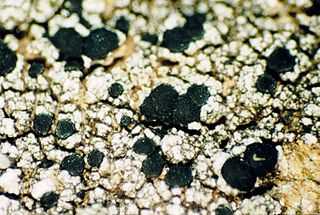
The Lecanoraceae are a family of lichenized fungi in the order Lecanorales. Species of this family have a widespread distribution.

The Mycocaliciaceae are a family of seven genera and about 90 species of fungi in the order Mycocaliciales.
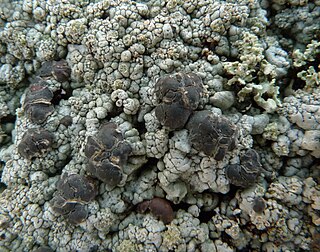
Trapeliopsis is a genus of lichenized fungi in the family Trapeliaceae. It contains 20 species. The genus was circumscribed in 1980 by Hannes Hertel and Gotthard Schneider, with Trapeliopsis wallrothii designated as the type species.

Calicium is a genus of leprose lichens. It is in the family Caliciaceae.

Anisomeridium is a genus of lichens in the family Monoblastiaceae. The type species was originally named Arthopyrenia xylogena by Swiss botanist Johannes Müller Argoviensis in 1883; in 1928, Maurice Choisy defined the genus Anisomeridium, designating A. xylogena the type species.
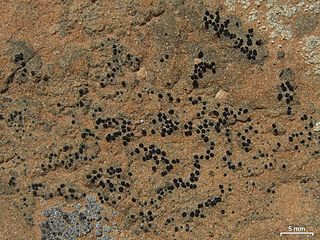
Staurothele is a genus of saxicolous (rock-dwelling), crustose lichens in the family Verrucariaceae. It has about 40 species. When the fungus is part of a lichen, the genus of lichen is commonly called rock pimples.

Canoparmelia is a genus of lichen-forming fungi in the family Parmeliaceae. The widespread genus contains about 35 species. Canoparmelia, a segregate of the parmelioid lichen genus Pseudoparmelia, was circumscribed by John Elix and Mason Hale in 1986.
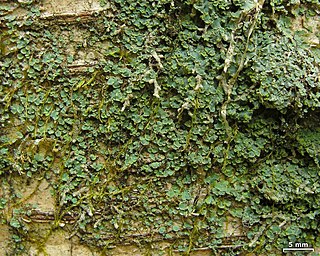
Normandina is a genus of lichen-forming fungi in the family Verrucariaceae. It has three species:

Pyrrhospora is a genus of lichen-forming fungi in the family Lecanoraceae. The genus was circumscribed by German lichenologist Gustav Wilhelm Körber in 1855, with Pyrrhospora quernea assigned as the type species.
Harpidium is a genus of lichen-forming fungi in the family Harpidiaceae. The genus contains three species. Harpidium was circumscribed in 1855 by German lichenologist Gustav Wilhelm Körber, with Harpidium rutilans assigned as the type species.

Chaenothecopsis is a genus of about 40 species of pin lichens in the family Mycocaliciaceae. Many of the species are resinicolous, meaning they grow on conifer resin or other plant exudates. Most common host plants are trees in the genera Abies, Picea, and Tsuga.
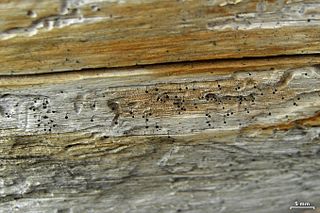
Mycocalicium is a genus of fungi in the family Mycocaliciaceae. The genus was circumscribed by Finnish lichenologist Edvard August Vainio in 1890.

Phaeocalicium is a genus of lichen-forming fungi in the family Mycocaliciaceae. The genus was circumscribed in 1970 by German lichenologist Alexander Schmidt, with Phaeocalicium praecedens assigned as the type species.
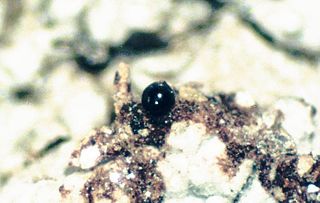
Sphinctrina is a genus of lichenicolous fungi, usually not lichenized, in the family Sphinctrinaceae. Its species are most commonly parasitic on lichens of the genus Pertusaria.

Absconditella is a genus of lichenised fungi in the family Stictidaceae. The genus was circumscribed in 1965 by Czech lichenologist Antonín Vězda, with Absconditella sphagnorum assigned as the type species. Absconditella is characterised by gyalectoid apothecia with a hymenium that is not amyloid, without a dark pigment and thalli containing green algae as photobionts. The genus name means "hidden", a reference to the scant structure of the thallus and its small apothecia.
Wegea is a genus of fungi within the order Arthoniales. The genus has not been placed into a family. This is a monotypic genus, containing the single species Wegea tylophorelloides. The genus was circumscribed in 1997 by André Aptroot and Leif Tibell. The species have a morphology similar to calicioid fungi, but does not form a mazaedium.
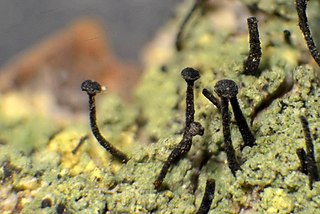
The Caliciaceae are a family of mostly lichen-forming fungi belonging to the class Lecanoromycetes in the division Ascomycota. Although the family has had its classification changed several times throughout its taxonomic history, the use of modern molecular phylogenetic methods have helped to establish its current placement in the order Caliciales. Caliciaceae contains 36 genera and about 600 species. The largest genus is Buellia, with around 300 species; there are more than a dozen genera that contain only a single species.

Thelenella is a genus of lichen-forming fungi in the family Thelenellaceae. It has 30 species. The genus was circumscribed by Finnish lichenologist William Nylander in 1855, with Thelenella modesta assigned as the type species.
Strangospora is a genus of lichen-forming fungi. It is the only genus in the family Strangosporaceae, which itself is of uncertain taxonomic placement in the Ascomycota. It contains 10 species.















